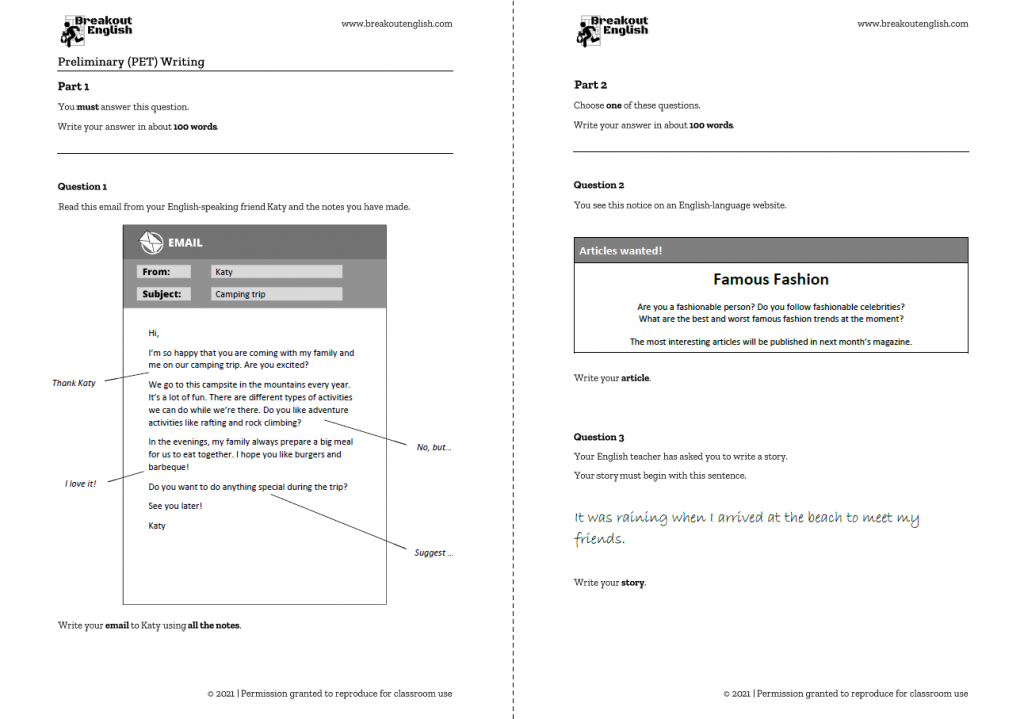Writing can be a scary thing for B1 learners, but with some training the Preliminary (PET) writing doesn’t have to make you run and hide. The important thing at B1 is to be clear, consistent and organised. You don’t need to write the next Charles Dickens novel, you just have to complete the task with good basic grammar, vocabulary, organisation and a little touch of style.
Here we’ve got some top tips for the Preliminary (PET) writing paper and two sample tests for you to use as practice at home or in the classroom. Each one could be used for PET for schools or for the regular adult exam.

Contents
What are the different types of writing for B1 Cambridge?
Part 1
The first part of the Cambridge B1 writing exam is an email. You will read an email that received from an English friend or family member. Next to this email, there are notes to include in your answer. You must answer the email in 100 words, including all the information from the notes. For more about how to write the perfect B1 PET Writing Part 1, take a look at our post about emails.
Part 2
The second part of the writing exam has two choices, an article or a story. Each one should be 100 words, but you only write one of them, not both. Some people prefer to practise one type of writing a lot to make it perfect, but it’s always a good idea to be comfortable with both. Sometimes the topic of one writing is strange, so you may prefer the other one. If you only know how to write one type, this becomes a problem.
Top tips for Preliminary (PET) writing
These tips will help you maximise the opportunity for points in the Cambridge writing criteria. Each writing is given a mark out of 5 in Content, Communicative Achievement, Organisation and Language.
- Answer the question (Content) – You wouldn’t believe how many people don’t include all the necessary content in their answers. Part 1 is very controlled and has four notes along the side of each input text. In order to score points in the Content mark, you must clearly include answers to all four notes. For example, if the note say “suggest”, pointing at a comment about what restaurant you’d like to go to, suggest a restaurant. It seems obvious, but it’s the easiest way to both lose and gain points. In Part 2, you’ll have a couple of content points in the article and less in the story, but you still need to stick to the topic. For example, if the story is about a day at the beach, don’t write about a birthday party.
- Use paragraphs (Organisation) – Another easy fix, but one that can seriously affect the Organisation mark. Even though the text is only 100 words, there should generally be 2-3 paragraphs, clearly separated using a line gap or indentation.
- Write the correct writing (Content, Communicative Achievement) – If it’s an email, it needs to look like an email with a simple “Hi” and “See you soon!” at the beginning and end. If it’s an article, it should have a title. If it’s a story, it should have a beginning, middle and end. The tone and style of each writing is slightly different too. Look at examples and consider what style is used.
- Punctuate (Organisation, Language) – Sometimes something as seemingly insignificant as a comma can completely change a writing. Be careful with sentences that are long, confusing and connected together with commas. Make sure you are finishing sentences when they are grammatically complete and not using incorrect punctuation.
- Use the past (Language) – To show you know B1 grammar, it’s important to use the past. In almost every writing, you will have the opportunity to use the past to talk about something that happened to you. Don’t forget to study the irregular verbs!
- Use some modal verbs (Language) – Another area of B1 language is modal verbs. Make a recommendation with “should” or talk about possibility with “can” or “can’t”. It’s not advanced language, but it’s something that shows you know B1 level English.
- Use a relative clause (Language) – If you want to score top points in Language, you have to attempt some complex grammar. Using subordinate clauses like relative clauses is a good way to do this. A sentence like “My brother, who lives in Miami, is going to visit me in Spain this summer” is a great way to include more complex grammar in your writing.
- Use basic linking words (Organisation, Language) – At B1, you don’t need to use a huge variety of linking words, but you should use “and”, “so”, “but”, “because” and possibly a few other more advanced ones like “however”, “although” and “also”. These should be used throughout all the writings.
- Make it interesting (Communicative Achievement) – You don’t need to be an expert writer to write an interesting text. For example, there’s a big difference between a story where the school closes because of a flood (interesting) and a day you went to school and did an exam (not interesting). The same applies to articles, if you write an article about travel and you talk about going on an adventure in Hawaii, it’s more interesting than going to the local swimming pool every day.
- Keep it simple (Everything) – Remember that it’s a B1 writing and in order to pass or even get high marks, you don’t need to make it complicated. Use the language you know to write the best possible writing within the expectations of the task. Don’t be afraid to attempt some complex things, but also make sure you do the basics well.
The materials
Here are two full Preliminary (PET) writing sample tests. These have been designed in the same format as official exams to practise and improve in preparation for the B1 writing exam. Remember that the time limit to complete both parts of the Preliminary (PET) Writing exam is 45 minutes.
Download





